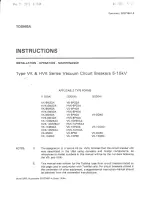
:To check the setting, arrange the breaker for "slow
close" as described in Section
7.4.
Through the use of a
continuity tester, observe the position of the breaker con
tacts when the switch's LI-LIC "A" contacts touch. At this
point the breaker's arcing contacts must be within
.250 "•
�
of closing.
Adjustment is made by disconnecting the upper end of
the adjustable link and varying its length as required.
7.7
SHUNT TRIP
The shunt trip device opens the breaker when its coil is
energized. An "A" auxiliary switch, which is closed only
when the breaker is closed, is in series with the device
coil. Connections are made to the external tripping source
through secondary disconnects on drawout breakers, or to
the auxiliary switch and terminal board on stationary
breakers.
The shunt trip is mounted to the underside of the
breaker front frame as shown in Fig.
29.
A second shunt
trip may also be mounted to the frame (see Fig. 30) if a se
cond undervoltage device isn't already installed, see Sec
tion
7.8.
7.7.1
REPLACEMENT
If it is necessary to replace or add one of these devices,
the easiest procedure is to remove the mounting bracket,
shown in Fig.
29,
from the breaker frame and remove the
device from the bracket. If a replacement or new device is
ordered, a mounting bracket will be supplied with the
device.
If a second shunt trip is added, this is mounted by
means of an additional bracket as shown in Fig. 30. This
additional bracket is fastened by two of the hex head bolts
used to fasten the buffer assembly to the breaker frame.
7.7.2
ADJUSTMENT
FIG.
29 -
SHUNT TRIP AND
UNDERVOLTAGE MOUNTING
If the breaker is disconnected, and for some reason the
breaker is to be operated manually, the undervoltage
device may be tied or wired down so that it will not cause
tripping.
The undervoltage device is mounted to the underside of
the breaker front frame as shown in Fig.
29.
A second
undervoltage may also be mounted to the frame (see Fig.
31) if a second shunt trip isn't already installed, see Sec
tion
7.7.
If a second undervoltage device is added, a new buffer
assembly block will be supplied; This is required for
clearance, in this case, the buffer assembly must be taken
off, disassembled, and remounted together with the
number two undervoltage device. Before disassembling the
original buffer, carefully measure the distance between the
faces of the threaded members as shown in Fig. 31, and set
this dimension carefully on the new assembly. Refer to the
breaker wiring diagram for the coil lead connections.
When these devices are installed or replaced, their
7.8.1
REPLACEMENT
positive ability to trip the breaker must be demonstrated.
This is done by placing a 1/32·inch shim between the ar
mature and magnet of the device and manually operating
the armature to trip the breaker.
If the shunt trip is not successful in this test, check the
mounting fasteners to make sure they are reasonably
tight. If they are, then bend the trip paddle on the trip shaft
to slightly reduce the distance between the trip arm of the
device and the trip paddle, and recheck
for
positive trip. If
this bending is necessary, be careful that it is not over·
If it is necessary to replace or add one of these devices,
the easiest procedure is to remove the mounting bracket
shown in Fig.
29,
from the breaker frame and remove the
device from the bracket. If
a
replacement or new device is
ordered, a mounting bracket will be supplied with the
device.
done.
Verify
that there is a
.030 ··.® ·
gap between the ' ,
�(,0
trip
arm and
t
h
e trip paddle with the breaker closed. This
gap is necessary to prevent nuisance tripping.
7.8
UN DERVOLTAGE DEVICE
The undervoltage deivce tnps the breaker when its coil
is
de-energtzed .
The leads of the coil are connected direct
ly to
secondary
disconnects or to a terminal board. Under
normal conditions. the coil remams energized and the
breaker may be closed.
"Drop-out" of the armature, with resultant breaker tripp.
ing, occurs when the voltage is reduced to less than
60
percent of the rated voltage. An open armature will render
the breaker incapable of closing. The armature "picks up"
and allows closing, if the voltage ts
85
percent or more of
its nominal value. Refer to Table
23.
Section
14
for the
ac·
tual drop out and pick up voltage ranges.
FIG. 30 -
2ND SHUNT TRIP INSTALLATION
23
www
. ElectricalPartManuals
. com











































